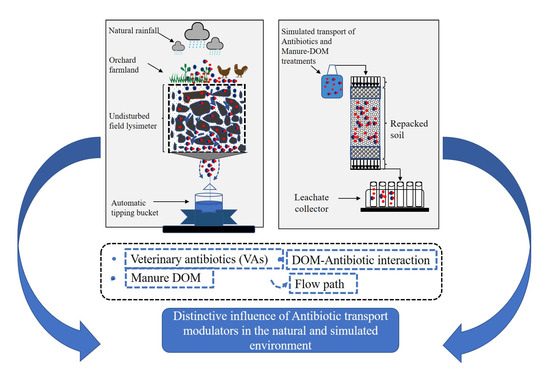Leaching of Sulfadiazine and Florfenicol in an Entisol of a Chicken-Raising Orchard: Impact of Manure-Derived Dissolved Organic Matter
Abstract
:1. Introduction
2. Materials and Methods
2.1. Chemicals and Reagents
2.2. Study Site and Experimental Setup
2.3. Sampling and Data Collection
2.3.1. Rainfall Events and Field Lysimeter Leachate
2.3.2. Chicken Manure-DOM Extraction and Column Experiments
2.4. Analyses
2.4.1. Sample Analysis
2.4.2. Mass Flux of SDZ and FFC
2.5. Modelling
2.5.1. One-Dimensional Transport and Sorption Parameters
2.5.2. Two-Site Nonequilibrium Adsorption Model
2.5.3. Two Kinetic Site Model
2.5.4. Data Analysis
3. Results and Discussion
3.1. Soil Water Flow Dynamics Corresponding to Natural Rainfall Events
3.2. Mass Flux of Sulfadiazine and Florfenicol in Lysimeter Leachate
3.3. EEM-PARAFAC Components during Rainfall Events
3.4. Response of Antibiotics Mass Flux to DOC and Optical Indices of DOM
3.5. FFC and SZD Breakthrough Curves in Repacked Soil Columns
3.6. Simulated SDZ and FFC Breakthrough Curves
4. Conclusions
Supplementary Materials
Author Contributions
Funding
Data Availability Statement
Acknowledgments
Conflicts of Interest
References
- Van Boeckel, T.P.; Brower, C.; Gilbert, M.; Grenfell, B.T.; Levin, S.A. Global Trends in Antimicrobial Use in Food Animals. Proc. Natl. Acad. Sci. USA 2015, 112, 5649–5654. [Google Scholar] [CrossRef] [PubMed] [Green Version]
- Krishnasamy, V.; Otte, J.; Silbergeld, E. Antimicrobial Use in Chinese Swine and Broiler Poultry Production. Antimicrob. Resist. Infect. Control 2015, 4, 17. [Google Scholar] [CrossRef] [PubMed] [Green Version]
- Chen, Y.S.; Zhang, H.B.; Luo, Y.M.; Song, J. Occurrence and Assessment of Veterinary Antibiotics in Swine Manures: A Case Study in East China. Chin. Sci. Bull. 2012, 57, 606–614. [Google Scholar] [CrossRef] [Green Version]
- Zhao, L.; Dong, Y.H.; Wang, H. Residues of Veterinary Antibiotics in Manures from Feedlot Livestock in Eight Provinces of China. Sci. Total Environ. 2010, 408, 1069–1075. [Google Scholar] [CrossRef] [PubMed]
- Wu, Z. Antibiotic Use and Antibiotic Resistance in Food-Producing Animals in China; OECD Food, Agriculture and Fisheries Working Papers; OECD Publishing: Paris, France, 2019. [Google Scholar] [CrossRef]
- Qiao, M.; Chen, W.; Su, J.; Zhang, B.; Zhang, C. Fate of Tetracyclines in Swine Manure of Three Selected Swine Farms in China. J. Environ. Sci. China 2012, 24, 1047–1052. [Google Scholar] [CrossRef]
- Sarmah, A.K.; Meyer, M.T.; Boxall, A.B.A. A Global Perspective on the Use, Sales, Exposure Pathways, Occurrence, Fate and Effects of Veterinary Antibiotics (VAs) in the Environment. Chemosphere 2006, 65, 725–759. [Google Scholar] [CrossRef]
- Jechalke, S.; Heuer, H.; Siemens, J.; Amelung, W.; Smalla, K. Fate and Effects of Veterinary Antibiotics in Soil. Trends Microbiol. 2014, 22, 536–545. [Google Scholar] [CrossRef]
- Kay, P.; Blackwell, P.A.; Boxall, A.B.A. Fate of Veterinary Antibiotics in a Macroporous Tile Drained Clay Soil. Environ. Toxicol. Chem. 2004, 23, 1136–1144. [Google Scholar] [CrossRef] [Green Version]
- Li, C.; Chen, J.; Wang, J.; Ma, Z.; Han, P.; Luan, Y.; Lu, A. Occurrence of Antibiotics in Soils and Manures from Greenhouse Vegetable Production Bases of Beijing, China and an Associated Risk Assessment. Sci. Total Environ. 2015, 521–522, 101–107. [Google Scholar] [CrossRef]
- Yi, X.; Lin, C.; Ong, E.J.L.; Wang, M.; Zhou, Z. Occurrence and Distribution of Trace Levels of Antibiotics in Surface Waters and Soils Driven by Non-Point Source Pollution and Anthropogenic Pressure. Chemosphere 2019, 216, 213–223. [Google Scholar] [CrossRef]
- Hu, X.; Zhou, Q.; Luo, Y. Occurrence and Source Analysis of Typical Veterinary Antibiotics in Manure, Soil, Vegetables and Groundwater from Organic Vegetable Bases, Northern China. Environ. Pollut. 2010, 158, 2992–2998. [Google Scholar] [CrossRef] [PubMed]
- Chen, C.; Li, J.; Chen, P.; Ding, R.; Zhang, P.; Li, X. Occurrence of Antibiotics and Antibiotic Resistances in Soils from Wastewater Irrigation Areas in Beijing and Tianjin, China. Environ. Pollut. 2014, 193, 94–101. [Google Scholar] [CrossRef] [PubMed]
- Joy, S.R.; Bartelt-Hunt, S.L.; Snow, D.D.; Gilley, J.E.; Woodbury, B.L.; Parker, D.B.; Marx, D.B.; Li, X. Fate and Transport of Antimicrobials and Antimicrobial Resistance Genes in Soil and Runoff Following Land Application of Swine Manure Slurry. Environ. Sci. Technol. 2013, 47, 12081–12088. [Google Scholar] [CrossRef] [PubMed] [Green Version]
- Song, W.; Guo, M. Residual Veterinary Pharmaceuticals in Animal Manures and Their Environmental Behaviors in Soils. In Applied Manure and Nutrient Chemistry for Sustainable Agriculture and Environment; Springer: Dordrecht, The Netherlands, 2014; pp. 23–52. [Google Scholar] [CrossRef]
- Chen, L.; Lang, H.; Liu, F.; Jin, S.; Yan, T. Presence of Antibiotics in Shallow Groundwater in the Northern and Southwestern Regions of China. Groundwater 2017, 56, 451–457. [Google Scholar] [CrossRef] [PubMed]
- Danner, M.C.; Robertson, A.; Behrends, V.; Reiss, J. Antibiotic Pollution in Surface Fresh Waters: Occurrence and Effects. Sci. Total Environ. 2019, 664, 793–804. [Google Scholar] [CrossRef]
- Sun, J.; Zeng, Q.; Tsang, D.C.W.; Zhu, L.Z.; Li, X.D. Antibiotics in the Agricultural Soils from the Yangtze River Delta, China. Chemosphere 2017, 189, 301–308. [Google Scholar] [CrossRef]
- Tong, L.; Qin, L.; Xie, C.; Liu, H.; Wang, Y.; Guan, C. Chemosphere Distribution of Antibiotics in Alluvial Sediment near Animal Breeding Areas at the Jianghan Plain, Central China. Chemosphere 2017, 186, 100–107. [Google Scholar] [CrossRef]
- Kay, P.; Blackwell, P.A.; Boxall, A.B.A. A Lysimeter Experiment to Investigate the Leaching of Veterinary Antibiotics through a Clay Soil and Comparison with Field Data. Environ. Pollut. 2005, 134, 333–341. [Google Scholar] [CrossRef]
- Pan, M.; Chu, L.M. Leaching Behavior of Veterinary Antibiotics in Animal Manure-Applied Soils. Sci. Total Environ. 2017, 579, 466–473. [Google Scholar] [CrossRef]
- Fan, W.; Guo, T.; Gao, S.; Lu, Y.; Meng, Y.; Huo, M. Evolution of Dissolved Organic Matter during Artificial Groundwater Recharge with Effluent from Underutilized WWTP and the Resulting Facilitated Transport Effect. Environ. Res. 2021, 193, 110527. [Google Scholar] [CrossRef]
- Xing, Y.; Chen, X.; Wagner, R.E.; Zhuang, J.; Chen, X. Coupled Effect of Colloids and Surface Chemical Heterogeneity on the Transport of Antibiotics in Porous Media. Sci. Total Environ. 2020, 713, 136644. [Google Scholar] [CrossRef] [PubMed]
- Zhang, L.; Zhu, D.; Wang, H.; Hou, L.; Chen, W. Humic Acid-Mediated Transport of Tetracycline and Pyrene in Saturated Porous Media. Environ. Toxicol. Chem. 2012, 31, 534–541. [Google Scholar] [CrossRef] [PubMed]
- Zhou, D.; Thiele-Bruhn, S.; Arenz-Leufen, M.G.; Jacques, D.; Lichtner, P.; Engelhardt, I. Impact of Manure-Related DOM on Sulfonamide Transport in Arable Soils. J. Contam. Hydrol. 2016, 192, 118–128. [Google Scholar] [CrossRef] [PubMed]
- Zou, Y.; Zheng, W. Modeling Manure Colloid-Facilitated Transport of the Weakly Hydrophobic Antibiotic Florfenicol in Saturated Soil Columns. Environ. Sci. Technol. 2013, 47, 5185–5192. [Google Scholar] [CrossRef] [PubMed] [Green Version]
- Boy-Roura, M.; Mas-Pla, J.; Petrovic, M.; Gros, M.; Soler, D.; Brusi, D.; Menció, A. Towards the Understanding of Antibiotic Occurrence and Transport in Groundwater: Findings from the Baix Fluvià Alluvial Aquifer (NE Catalonia, Spain). Sci. Total Environ. 2018, 612, 1387–1406. [Google Scholar] [CrossRef] [PubMed]
- Burke, V.; Richter, D.; Greskowiak, J.; Mehrtens, A.; Schulz, L.; Massmann, G. Occurrence of Antibiotics in Surface and Groundwater of a Drinking Water Catchment Area in Germany. Water Environ. Res. 2016, 88, 652–659. [Google Scholar] [CrossRef]
- Lei, K.; Han, X.; Fu, G.; Zhao, J.; Yang, L. Mechanism of Ofloxacin Fluorescence Quenching and Its Interaction with Sequentially Extracted Dissolved Organic Matter from Lake Sediment of Dianchi, China. Environ. Monit. Assess. 2014, 186, 8857–8864. [Google Scholar] [CrossRef]
- Bai, L.; Zhao, Z.; Wang, C.; Wang, C.; Liu, X.; Jiang, H. Multi-Spectroscopic Investigation on the Complexation of Tetracycline with Dissolved Organic Matter Derived from Algae and Macrophyte. Chemosphere 2017, 187, 421–429. [Google Scholar] [CrossRef]
- Lou, Y.; Ye, Z.L.; Chen, S.; Wei, Q.; Zhang, J.; Ye, X. Influences of Dissolved Organic Matters on Tetracyclines Transport in the Process of Struvite Recovery from Swine Wastewater. Water Res. 2018, 134, 311–326. [Google Scholar] [CrossRef]
- Xu, J.; Yu, H.Q.; Sheng, G.P. Kinetics and Thermodynamics of Interaction between Sulfonamide Antibiotics and Humic Acids: Surface Plasmon Resonance and Isothermal Titration Microcalorimetry Analysis. J. Hazard. Mater. 2016, 302, 262–266. [Google Scholar] [CrossRef]
- Ahmed, A.A.; Thiele-Bruhn, S.; Aziz, S.G.; Hilal, R.H.; Elroby, S.A.; Al-Youbi, A.O.; Leinweber, P.; Kühn, O. Interaction of Polar and Nonpolar Organic Pollutants with Soil Organic Matter: Sorption Experiments and Molecular Dynamics Simulation. Sci. Total Environ. 2015, 508, 276–287. [Google Scholar] [CrossRef] [PubMed] [Green Version]
- Xiao, Y.H.; Huang, Q.H.; Vähätalo, A.V.; Li, F.P.; Chen, L. Effects of Dissolved Organic Matter from a Eutrophic Lake on the Freely Dissolved Concentrations of Emerging Organic Contaminants. Environ. Toxicol. Chem. 2014, 33, 1739–1746. [Google Scholar] [CrossRef] [PubMed]
- Yang, F.; Zhang, Q.; Jian, H.; Wang, C.; Xing, B.; Sun, H.; Hao, Y. Effect of Biochar-Derived Dissolved Organic Matter on Adsorption of Sulfamethoxazole and Chloramphenicol. J. Hazard. Mater. 2020, 396, 122598. [Google Scholar] [CrossRef] [PubMed]
- Zhao, X.; Hu, Z.; Yang, X.; Cai, X.; Wang, Z.; Xie, X. Noncovalent Interactions between Fluoroquinolone Antibiotics with Dissolved Organic Matter: A 1H NMR Binding Site Study and Multi-Spectroscopic Methods. Environ. Pollut. 2019, 248, 815–822. [Google Scholar] [CrossRef]
- Zhang, W.; Tang, X.Y.; Weisbrod, N.; Zhao, P.; Reid, B.J. A Coupled Field Study of Subsurface Fracture Flow and Colloid Transport. J. Hydrol. 2015, 524, 476–488. [Google Scholar] [CrossRef]
- Zhao, P.; Tang, X.; Zhao, P.; Wang, C.; Tang, J. Identifying the Water Source for Subsurface Flow with Deuterium and Oxygen-18 Isotopes of Soil Water Collected from Tension Lysimeters and Cores. J. Hydrol. 2013, 503, 1–10. [Google Scholar] [CrossRef]
- Wang, H.L. Study on Soil Hydraulic Parameters of Forest Land and Sloping Farmland in the Hilly Area of Central Sichuan Basin; Northwest A&F University: Yangling, China, 2013. [Google Scholar]
- Haham, H.; Oren, A.; Chefetz, B. Insight into the Role of Dissolved Organic Matter in Sorption of Sulfapyridine by Semiarid Soils. Environ. Sci. Technol. 2012, 46, 11870–11877. [Google Scholar] [CrossRef]
- Stedmon, C.A.; Bro, R. Characterizing Dissolved Organic Matter Fluorescence with Parallel Factor Analysis: A Tutorial. Limnol. Oceanogr. Methods 2008, 6, 572–579. [Google Scholar] [CrossRef]
- Cory, R.M.; McKnight, D.M. Fluorescence Spectroscopy Reveals Ubiquitous Presence of Oxidized and Reduced Quinones in Dissolved Organic Matter. Environ. Sci. Technol. 2005, 39, 8142–8149. [Google Scholar] [CrossRef]
- Ohno, T. Fluorescence Inner-Filtering Correction for Determining the Humification Index of Dissolved Organic Matter. Environ. Sci. Technol. 2002, 36, 742–746. [Google Scholar] [CrossRef]
- Simunek, J.; Sejna, M.; Saito, H.; Genuchten, M.T.V. The HYDRUS-1D Software Package for Simulating the One-Dimensional Movement of Water, Heat, and Multiple Solutes in Variably-Saturated Media; University of California Riverside: Riverside, CA, USA, 2008. [Google Scholar]
- Selim, H.M.; Davidson, J.M.; Mansell, R.S. Evaluation of a Two-Site Adsorption–Desorption Model for Describing Solute Transport in Soil. In Proceedings of the Conference on Applications of Continuous System Simulation Languages, Washington, DC, USA, 12–14 July 1976; pp. 444–448. [Google Scholar]
- van Genuchten, M.T.; Wagenet, R.J. Two-Site/Two-Region Models for Pesticide Transport and Degradation: Theoretical Development and Ana Lytical Solutions. Soil Sci. Soc. Am. J. 1989, 53, 1303–1310. [Google Scholar] [CrossRef]
- Šimůnek, J.; Jacques, D.; Langergraber, G.; Bradford, S.A.; Šejna, M.; Van Genuchten, M.T. Numerical Modeling of Contaminant Transport Using HYDRUS and Its Specialized Modules. J. Indian Inst. Sci. 2013, 93, 265–284. [Google Scholar]
- Gbadegesin, L.A.; Tang, X.; Liu, C.; Cheng, J. Transport of Veterinary Antibiotics in Farmland Soil: Effects of Dissolved Organic Matter. Int. J. Environ. Res. Public Health 2022, 19, 1702. [Google Scholar] [CrossRef] [PubMed]
- Zhang, W.; Tang, X.Y.; Xian, Q.S.; Weisbrod, N.; Yang, J.E.; Wang, H.L. A Field Study of Colloid Transport in Surface and Subsurface Flows. J. Hydrol. 2016, 542, 101–114. [Google Scholar] [CrossRef]
- Wang, N.; Guo, X.; Xu, J.; Hao, L.; Kong, D.; Gao, S. Sorption and Transport of Five Sulfonamide Antibiotics in Agricultural Soil and Soil–Manure Systems. J. Environ. Sci. Health Part B Pestic. Food Contam. Agric. Wastes 2015, 50, 23–33. [Google Scholar] [CrossRef]
- Engelhardt, I.; Sittig, S.; Šimůnek, J.; Groeneweg, J.; Pütz, T.; Vereecken, H. Fate of the Antibiotic Sulfadiazine in Natural Soils: Experimental and Numerical Investigations. J. Contam. Hydrol. 2015, 177–178, 30–42. [Google Scholar] [CrossRef] [Green Version]
- Sukul, P.; Lamshöft, M.; Zühlke, S.; Spiteller, M. Sorption and Desorption of Sulfadiazine in Soil and Soil-Manure Systems. Chemosphere 2008, 73, 1344–1350. [Google Scholar] [CrossRef]
- Conde-Cid, M.; Fernández-Calviño, D.; Fernández-Sanjurjo, M.J.; Núñez-Delgado, A.; Álvarez-Rodríguez, E.; Arias-Estévez, M. Adsorption/Desorption and Transport of Sulfadiazine, Sulfachloropyridazine, and Sulfamethazine, in Acid Agricultural Soils. Chemosphere 2019, 234, 978–986. [Google Scholar] [CrossRef]
- Tang, X.; Liu, C.; Luo, F.; Li, S.; Yang, H. Effects of Colloidal Manure DOM on the Transport of Antibiotics in Calcareous Soils. In Proceedings of the EGU General Assembly 2021, Online, 19–30 April 2021. [Google Scholar] [CrossRef]
- Gao, J.; Shi, Z.; Gao, J.; Wu, H.; Lv, J. Fluorescent Characteristics of Dissolved Organic Matter Released from Biochar and Paddy Soil Incorporated with Biochar. RSC Adv. 2020, 10, 5785–5793. [Google Scholar] [CrossRef]
- Liu, C.; Li, Z.; Berhe, A.A.; Xiao, H.; Liu, L.; Wang, D.; Peng, H.; Zeng, G. Characterizing Dissolved Organic Matter in Eroded Sediments from a Loess Hilly Catchment Using Fluorescence EEM-PARAFAC and UV–Visible Absorption: Insights from Source Identification and Carbon Cycling. Geoderma 2019, 334, 37–48. [Google Scholar] [CrossRef]
- Xian, Q.; Li, P.; Liu, C.; Cui, J.; Guan, Z.; Tang, X. Concentration and Spectroscopic Characteristics of DOM in Surface Runoff and Fracture Flow in a Cropland Plot of a Loamy Soil. Sci. Total Environ. 2018, 622–623, 385–393. [Google Scholar] [CrossRef] [PubMed]
- Zhang, Y.; Zhang, B.; He, Y.; Lev, O.; Yu, G.; Shen, G.; Hu, S. DOM as an Indicator of Occurrence and Risks of Antibiotics in a City-River-Reservoir System with Multiple Pollution Sources. Sci. Total Environ. 2019, 686, 276–289. [Google Scholar] [CrossRef] [PubMed]
- Mu, G.; Ji, M.; Li, S. Evaluation of CDOM Sources and Their Links with Antibiotics in the Rivers Dividing China and North Korea Using Fluorescence Spectroscopy. Environ. Sci. Pollut. Res. 2018, 25, 27545–27560. [Google Scholar] [CrossRef] [PubMed]
- Wehrhan, A.; Kasteel, R.; Simunek, J.; Groeneweg, J.; Vereecken, H. Transport of Sulfadiazine in Soil Columns—Experiments and Modelling Approaches. J. Contam. Hydrol. 2007, 89, 107–135. [Google Scholar] [CrossRef]
- Unold, M.; Šimůnek, J.; Kasteel, R.; Groeneweg, J.; Vereecken, H. Transport of Manure-Based Applied Sulfadiazine and Its Main Transformation Products in Soil Columns. Vadose Zone J. 2009, 8, 677–689. [Google Scholar] [CrossRef]


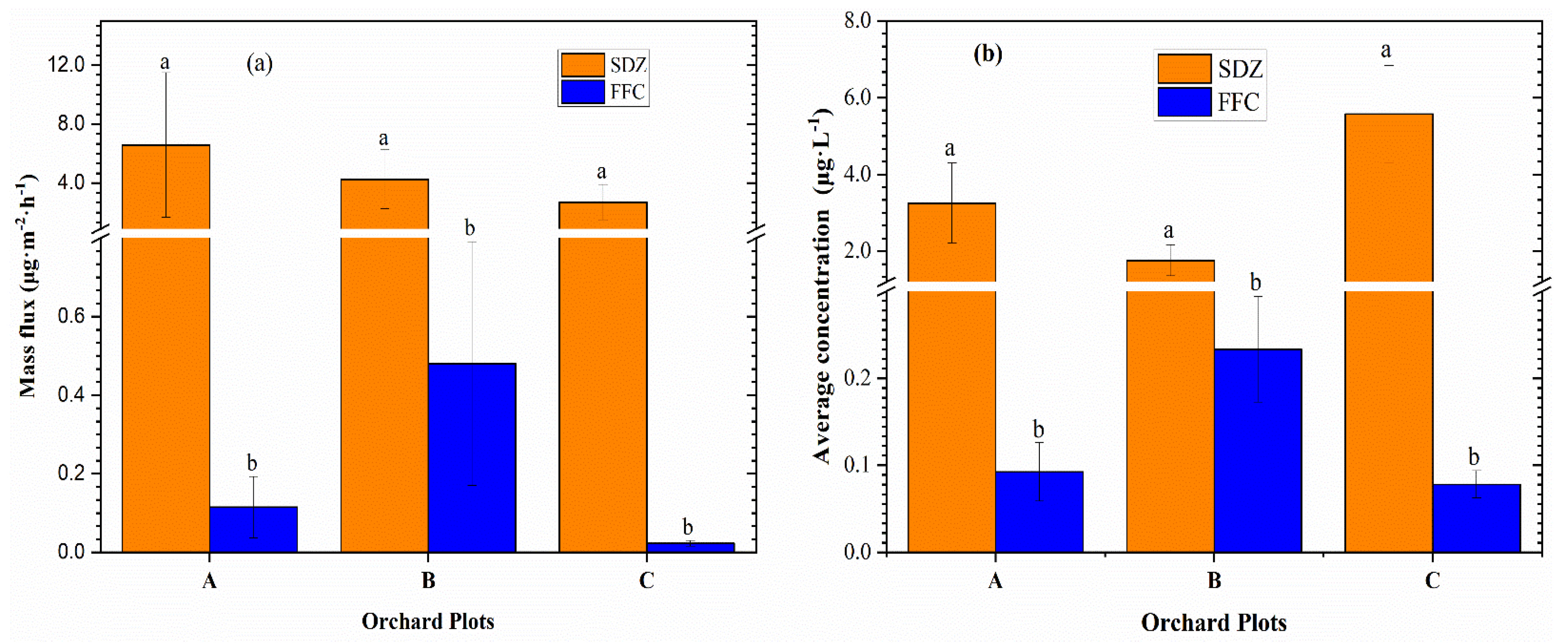
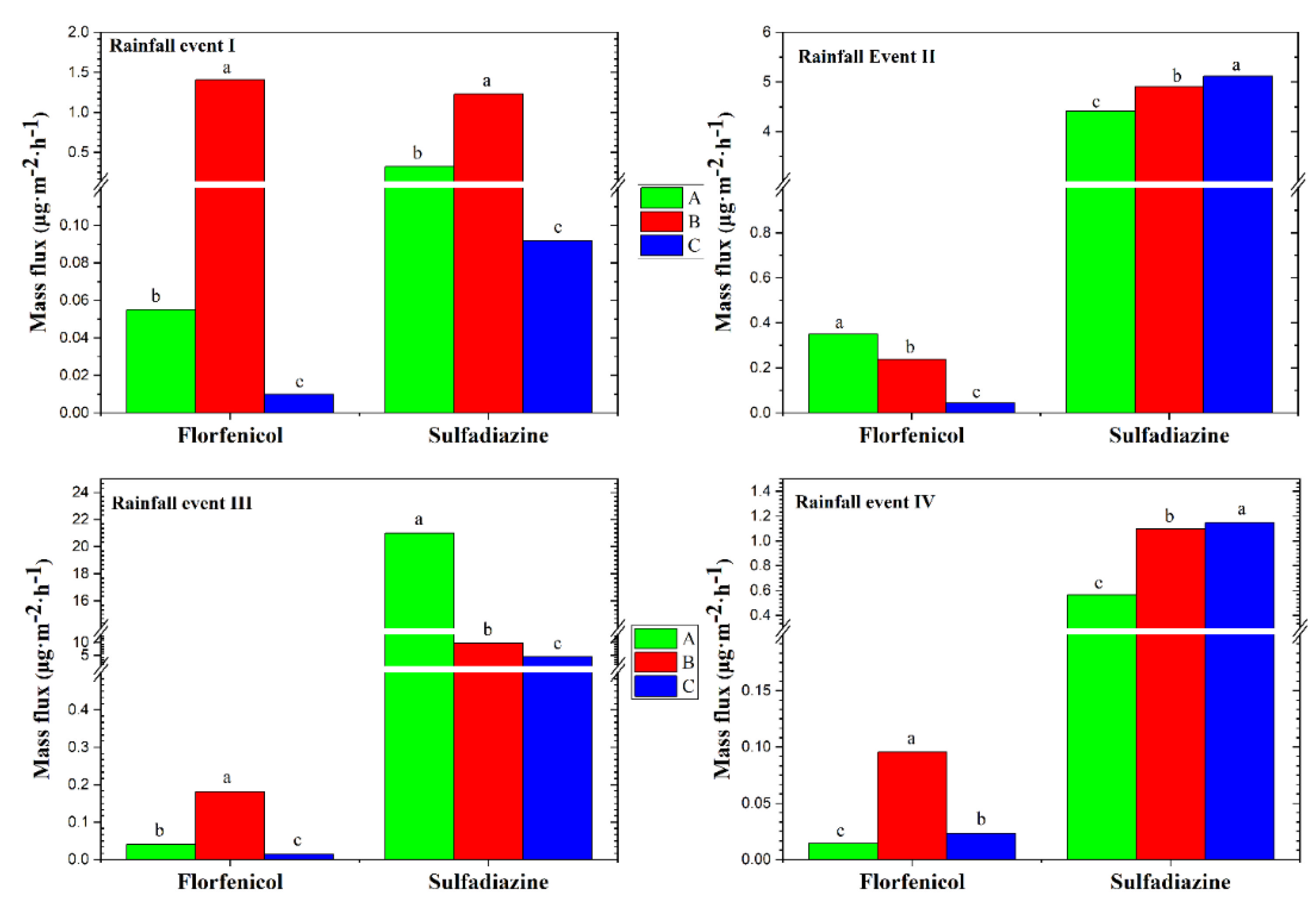

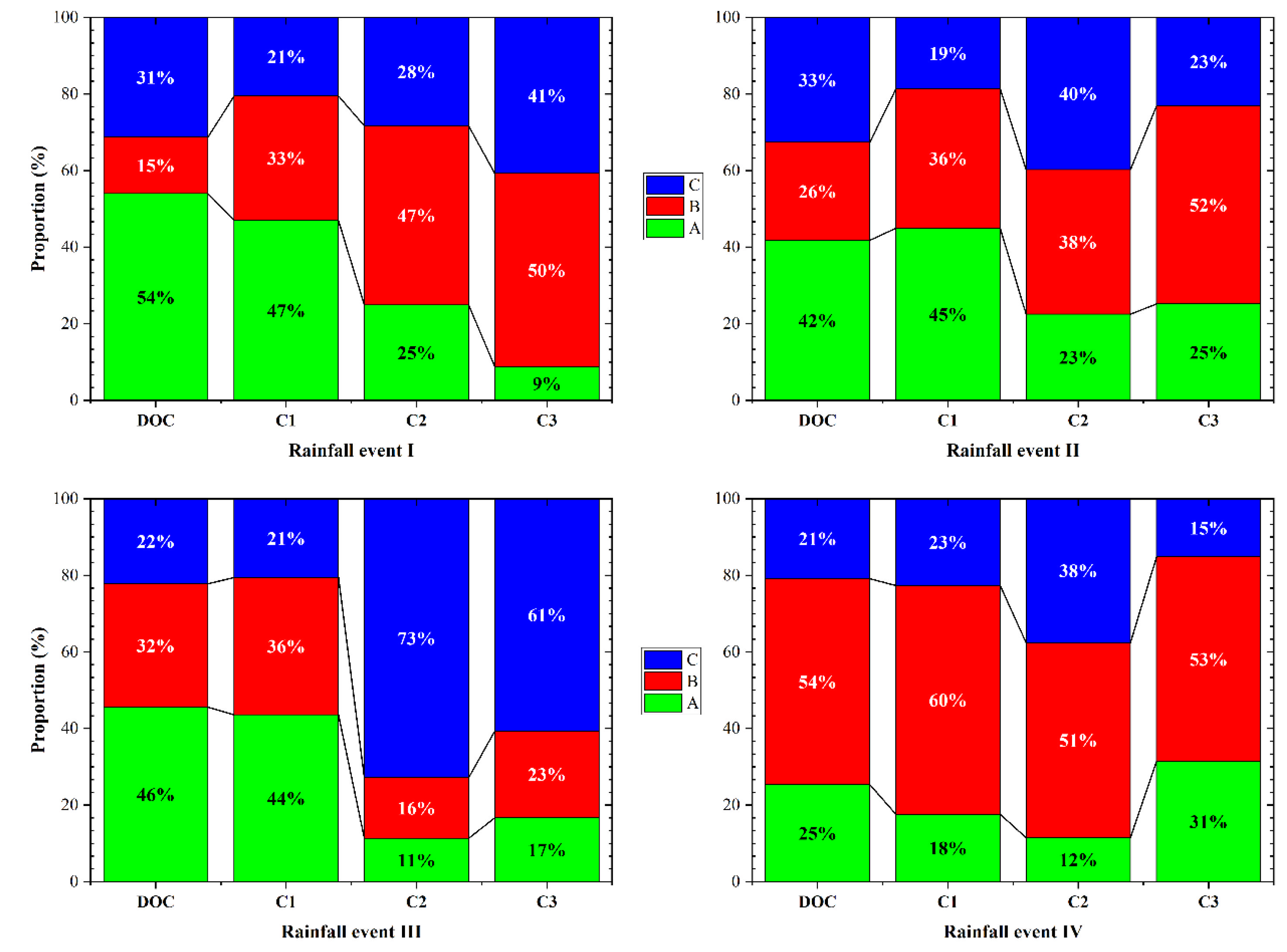
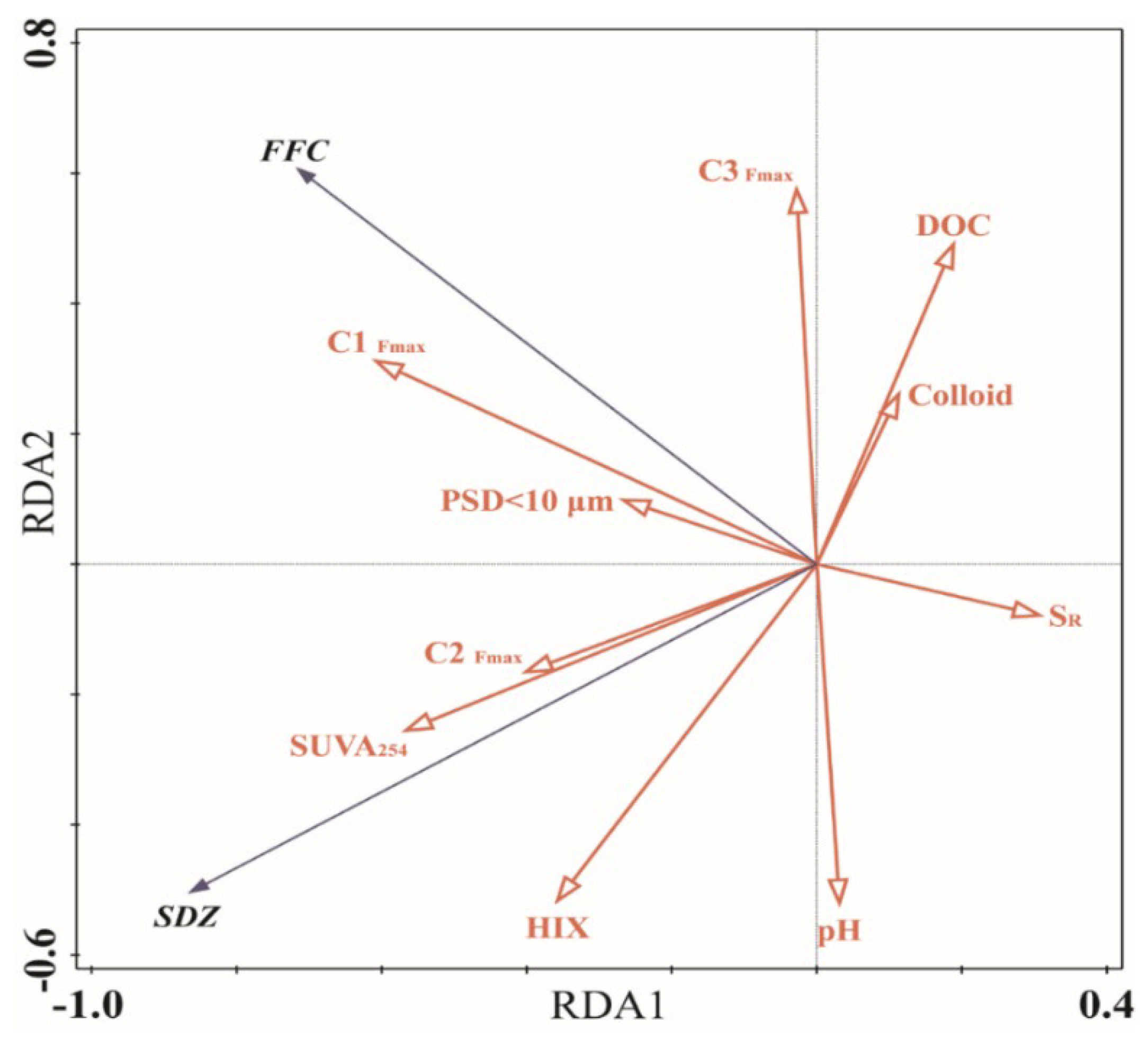

| Rainfall Events | Rainfall Amount | Duration | Maximum Intensity | Preceded Dry Days | Average Leachate Discharge per 15 min (cm3 h–1) | ||
|---|---|---|---|---|---|---|---|
| (mm) | (h) | (mm/15 min) | (days) | Plot A | Plot B | Plot C | |
| 12 August 2020 | 17.2 | 4 | 32.8 | 3 | 68.13 | 165.31 | 4.06 |
| 13 August 2020 | 46.6 | 17 | 28.8 | 1 | 104.06 | 89.14 | 28.75 |
| 15 August 2020 | 16 | 5 | 22.4 | 2 | 145.50 | 226 | 35 |
| 18 August 2020 | 20.2 | 11 | 12 | 3 | 77.73 | 190.91 | 51.59 |
| Samples | Sand | Texture | pH | OC | DOC | CEC | ρ | |
|---|---|---|---|---|---|---|---|---|
| Silt | Clay | (-) | (g kg−1) | (mg L−1) | (cmol kg−1) | (g cm−3) | ||
| Orchard soil | 30% | 66% | 4% | 7.98 ± 0.14 | 15.52 ± 1.11 | 38.2 ± 0.54 | 18.2 ± 0.64 | 1.49 ± 0.10 |
| Chicken manure | ND | ND | ND | 7.28 ± 0.20 | 486.25 ± 2.56 | 7977 ± 3.24 | 53.41 ± 0.84 | ND |
| Antibiotics | Column | ka1 (min–1) | ka2 (min–1) | kd1 (min–1) | kd2 (min–1) | R2 | RMSE | EM% |
|---|---|---|---|---|---|---|---|---|
| SDZ | Control | 4.78 × 10−3 (±8.70 × 10−4) | 0.36 (±0.02) | 5.24 × 10−4 (±8.9 × 10−5) | 1.13 (±0.02) | 0.988 | 5.31 × 10−2 | 95.70 |
| SDZ | Pre-coated | 0.025725 (±0.01) | 1.55 × 10−3 (±2.3 × 10−4) | 4.20 × 10−3 (±8.8 × 10−4) | 1.15 × 10−6 (±6.49 × 10−5) | 0.990 | 1.61 × 10−2 | 84.07 |
| SDZ | Co-transport | 0.033289 (±3.7 × 10−3) | 6.07 × 10−4 (±2.75 × 10−5) | 1.16 × 10−6 (±3.20 × 10−5) | 6.58 × 10−4 (±1.60 × 10−5) | 0.995 | 1.21 × 10−2 | 91.64 |
| FFC | Control | 8.35 × 10 – 4 (±3.18 × 10−5) | 0.16(±0.06) | 3.36 × 10−5 (±1.18 × 10−4) | 0.32491 (±2.9 × 10−3) | 0.973 | 7.87 × 10−2 | 89.21 |
| FFC | Pre-coated | 0.03 (±4.00 × 10−3) | 1.28 × 10−3 (±8.99 × 10−5) | 3.46 × 10−4 (±7.98 × 10−5) | 1.23 × 10 − 5 (±5.29 × 10−5) | 0.987 | 1.85 × 10−2 | 81.32 |
| FFC | Co-transport | 0.05 (±4.95 × 10−3) | 1.73 × 10−3 (±9.83 × 10−5) | 9.46 × 10−6 (±2.61 × 10−5) | 3.16 × 10−4 (±3.02 × 10−5) | 0.989 | 3.73 × 10−2 | 81.13 |
Publisher’s Note: MDPI stays neutral with regard to jurisdictional claims in published maps and institutional affiliations. |
© 2022 by the authors. Licensee MDPI, Basel, Switzerland. This article is an open access article distributed under the terms and conditions of the Creative Commons Attribution (CC BY) license (https://creativecommons.org/licenses/by/4.0/).
Share and Cite
Gbadegesin, L.A.; Liu, X.; Tang, X.; Liu, C.; Cui, J. Leaching of Sulfadiazine and Florfenicol in an Entisol of a Chicken-Raising Orchard: Impact of Manure-Derived Dissolved Organic Matter. Agronomy 2022, 12, 3228. https://doi.org/10.3390/agronomy12123228
Gbadegesin LA, Liu X, Tang X, Liu C, Cui J. Leaching of Sulfadiazine and Florfenicol in an Entisol of a Chicken-Raising Orchard: Impact of Manure-Derived Dissolved Organic Matter. Agronomy. 2022; 12(12):3228. https://doi.org/10.3390/agronomy12123228
Chicago/Turabian StyleGbadegesin, Lanre Anthony, Xinyu Liu, Xiangyu Tang, Chen Liu, and Junfang Cui. 2022. "Leaching of Sulfadiazine and Florfenicol in an Entisol of a Chicken-Raising Orchard: Impact of Manure-Derived Dissolved Organic Matter" Agronomy 12, no. 12: 3228. https://doi.org/10.3390/agronomy12123228
APA StyleGbadegesin, L. A., Liu, X., Tang, X., Liu, C., & Cui, J. (2022). Leaching of Sulfadiazine and Florfenicol in an Entisol of a Chicken-Raising Orchard: Impact of Manure-Derived Dissolved Organic Matter. Agronomy, 12(12), 3228. https://doi.org/10.3390/agronomy12123228






